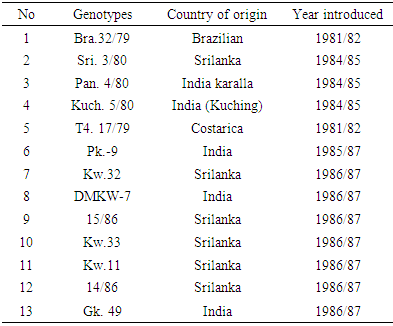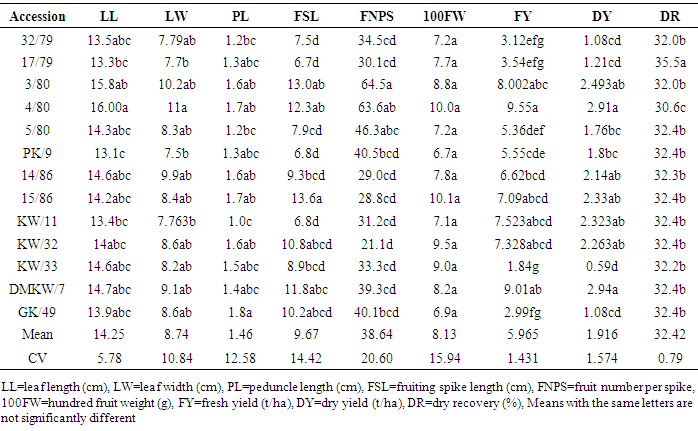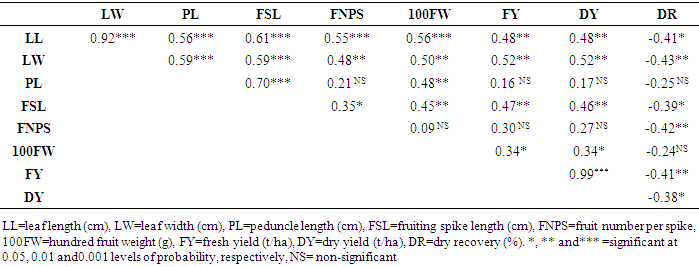-
Paper Information
- Paper Submission
-
Journal Information
- About This Journal
- Editorial Board
- Current Issue
- Archive
- Author Guidelines
- Contact Us
International Journal of Agriculture and Forestry
p-ISSN: 2165-882X e-ISSN: 2165-8846
2017; 7(2): 52-55
doi:10.5923/j.ijaf.20170702.03

Morpho-Genetic Variability and Character Correlation among Thirteen Black Pepper Accessions
Dejene Bekele1, Andargachew Gedebo2, Haimanot Mitiku1
1Ethiopian Institute of Agricultural Research, Tepi National Spice Research Centre, Ethiopia
2School of Plant and Horticultural Sciences, Hawassa University, Hawassa, Ethiopia
Correspondence to: Andargachew Gedebo, School of Plant and Horticultural Sciences, Hawassa University, Hawassa, Ethiopia.
| Email: |  |
Copyright © 2017 Scientific & Academic Publishing. All Rights Reserved.
This work is licensed under the Creative Commons Attribution International License (CC BY).
http://creativecommons.org/licenses/by/4.0/

An investigation was conducted to assess genetic variability and character correlation among 13 black pepper accessions. The objectives of the study were to characterize and estimate the magnitude of genetic variability, heritability and genetic advance based on morphological traits among thirteen black pepper accessions imported to Ethiopia. The experiment was carried out in a randomized complete block design with three replications. Accessions differed significantly (p<0.05) for all characters showing presence of sufficient usable variation. Morphological data ranged between 13.1-16 cm for leaf length, 7.5-11 cm for leaf width, 1.00-1.8 cm for peduncle length, 6.7-13.6 cm for fruiting spike length, 21.1-64.5 for fruit number per spike, 6.7-10.0 g for hundred fruit weight, 1.84-9.55 ton/ha for fresh yield, 0.59-2.94 ton/ha for dry weight and 30.6- 35.5% for dry recovery. The PCV values were relatively greater than GCV for all traits; however, the GCV values were near to PCV values indicating very little contribution of environment for phenotypic expression of these characters. Heritability in broad sense (h2b) ranged between 85.75-99.28, and expected genetic advance as percentage of the mean (GAM) ranged from 11.32-145.37. High heritability coupled with high genetic advance for characters reflecting the presence of additive gene action for the expression of these characters, and improving of these characters could be done through selection. Correlation coefficient indicated significantly positive correlation of four characters (leaf length, leaf width, fruiting spike length and hundred fruit weight) with the yield traits (fresh yield and dry yield). Hence selection for fresh yield and dry yield on the basis of these four traits could yield reliable result.
Keywords: Black Pepper, Heritability, Genetic Advance
Cite this paper: Dejene Bekele, Andargachew Gedebo, Haimanot Mitiku, Morpho-Genetic Variability and Character Correlation among Thirteen Black Pepper Accessions, International Journal of Agriculture and Forestry, Vol. 7 No. 2, 2017, pp. 52-55. doi: 10.5923/j.ijaf.20170702.03.
Article Outline
1. Introduction
- Black pepper (Piper nigrum L.) belongs to the family Piperaceae. It is cultivated for its fruit, which is usually dried and used as a spice and seasoning. Black pepper is considered as the king of spices mainly due to the presence of piperine, a pungent alkaloid [1] and extensively used all over the world. It can be used for medicine, human dietaries, preservatives and biocontrol agents [1]. The essential oil from black pepper possesses antioxidant and antimicrobial activities [2]. Black pepper is originated from the Western Ghats in south India, but later spread to Indonesia, Malaysia, and other pepper producing countries [3]. In Ethiopia many farmers are interested to cultivate black pepper because it is part of the daily meal as a spice and as a source of cash from its sell. Nationally it is among spice crops the country has begun to export. However, the supply for both local and export market is limited due to low production and productivity. Research work on improving its productivity has also been very scant. Increased productivity needs both genetic manipulation and proper crop management. Among others developing varieties that fit to the suitable agro ecological conditions and having desirable characters needs attention. The success of crop improvement program depends on the amount of genetic variation present in a crop and the magnitude of the variation which is heritable from the parent to the progeny [4]. Knowledge on genetic variability of black pepper genotypes in Ethiopia was limited. Therefore, there is a need to generate information on genetic variability, genotypic coefficient of variation, heritability, and genetic advance of available black pepper accessions that were introduced from other countries. Heritability estimate provides information on the extent to which a particular character can be transmitted from the parent to the progeny [5]. Genetic advance shows the degree of the gain obtained in a character from one cycle of selection. High genetic advance coupled with high heritability estimates offers the most suitable condition to decide the criteria of selection [6]. In view of these, the present study was done with the objectives to characterize and assess the magnitude of genetic variability, heritability, genetic advance and character correlation of thirteen black pepper accessions based on morphological traits.
2. Materials and Methods
2.1. Study Area
- The study was conducted at Teppi National Spice Research Centre (TNSRC) of Ethiopia (7°3′N, 35°18′E and elevation 1200 m). Teppi is located in Yeki woreda (sub-administrative zone), that is in Sheka zone within Southern Nations Nationalities and peoples Regional State (SNNPRS) of Ethiopia. Its average annual rain is 1678 mm; average annual maximum and minimum temperatures are 25.5 and 14.2°C respectively (16).
2.2. Experimental Treatments and Design
- The treatments were 13 accessions of black pepper introduced from four different countries of the world (Table 1). The experimental design was Randomized Complete Block with three replications. The spacing between support trees is 2.4 m by 2.4 m. Black pepper was planted 30 cm away from each support tree (only in one side of the support tree, in unidirectional pattern). Accordingly the pacing between rows and between plants within a row is equal, therefore 2.4 m. The experiment was designed to be continuous as the plant is perennial. It was first planted in July 2008. Uniform management including pruning, weeding and fertilizing has been made to all plots.
|
2.3. Data Collection and Statistical Analysis
- Morphologic data viz. leaf length; leaf width; peduncle length; fruiting spike length; fruit number/spike; hundred fruit weight; fresh yield; dry yield; dry recovery (%) were recorded on the basis of International Plant Genetic Resource Institute Descriptors for black pepper [7].The analysis of variance (ANOVA) and correlation analysis were done using Minitab version 16. Differences among treatment means were compared using Least Significant Difference (LSD). Significances were declared at the probability level of 0.05. The variance components: genotypic variance (GV), phenotypic variances (PV) and environmental variance (EV) were determined from mean square values of the ANOVA for each trait according to Reference [4]. The variance components were used to compute the genotypic coefficient of variability (GCV), phenotypic coefficient of variability (PCV), broad sense heritability (h2b), expected genetic advance (GA) and expected genetic advance as percentage of the mean (GAM), according to the methods of Reference [8-10].
3. Results and Discussion
3.1. Morphological Characters
- For the morphological characters, leaf length ranged between 13.1-16 cm, leaf width 7.5-11 cm, peduncle length 1.00-1.8 cm, fruiting spike length 6.7-13.6 cm, fruit number per spike 21.1-64.5, hundred fruit weight 6.7-10.0 gm, fresh yield 1.84-9.55 ton/ha, dry weight 0.59-2.94 ton/ha, dry recovery 30.6-35.5 (Table 2). Accessions differed significantly (p<0.05) in all morphological characters except in hundred fruit weight, showing presence of sufficient usable variation. According to Reference [4] the success of crop improvement program depends on the amount of heritable genetic variation present in a crop. Hence the result shows presence of sufficient usable variation. Accessions 3/80 and 4/80 had the highest values in most parameters; accession DMKW/7 had the highest values in fresh yield, dry yield and dry matter recovery (Table 2). These accessions could be considered for immediate advancement.
|
3.2. Variance Components, Heritability and Genetic Advance
- The estimates of genotypic variance (GV) ranged between 0.16-1794.64 and Phenotypic variance (PV) 0.17-1818.94 and error variance (EV) 0.03-72.9 (Table 3). The phenotypic and genotypic variances were near to each other and greater than the error variances. This shows the genotypic component was the major contributor to the total variance for morphological traits.Phenotypic coefficients of variation (PCV) ranged between 5.53-71.52; and genotypic coefficients of variation (GCV) between 5.51-71.04 (Table 3). The PCV values were relatively higher than the GCV values for all the parameters indicating environmental influence on the expression of the traits [11]. However, GCV values were near to PCV values for all characters. Such differences indicate very low contribution of environment for the phenotypic expression of these characters [12]. Heritability (h2b) values ranged between 90.29% for number of stem to 99.28% for percentage germination. The genetic advance as a percentage of the mean (GAM) also ranged from 11.32 for number of stem to 145.37 for economic yield (Table 4). The response of a character to selection is more reliable when heritability estimates and genetic advance are combined [13]. For all characters high heritability is accompanied by high genetic advance. This can be considered as a favourable attribute and indication of additive gene effect [14]. Where additive genes are less affected by environment, phenotypic selection for these traits will be effective [15].
|
|
3.3. Correlation Analysis
- Correlation coefficient indicated that leaf length, leaf width, fruiting spike length and hundred fruit weight had positive and significant correlation among them and had positive and significant correlation with fresh yield and dry yield (Table 4). This suggested that selection for fresh yield and dry yield on the basis of these traits will yield reliable result. In contrary, dry recovery percent had significantly negative correlation with fresh yield and dry yield. Peduncle length and fruit number per spike had positive and significant correlation among them and with fruiting spike length but do not have direct correlation with fresh yield and dry yield (Table 4). This indicated that selection for fresh yield and dry yield on the basis of these traits may not yield reliable result.
4. Conclusions
- It can be concluded that black pepper accessions significantly differed for important agro-morphological traits showing presence of sufficient usable variation. The phenotypic expressions revealed by morphological differences are more due to genotypic effect than environmental. All the studded traits exhibited high heritability and high genetic gain reflecting the presence of additive gene action for the expression of these traits, hence improving these characters could be done through selection.The presence of significantly positive correlation of four characters (leaf length, leaf width, fruiting spike length and hundred fruit weight) with the yield traits (fresh yield and dry yield) suggested that selection for fresh yield and dry yield on the basis of these four traits could yield reliable result.
ACKNOWLEDGEMENTS
- The work was financed by the Ethiopian Agricultural Research Institute. The support was given to Mr Dejene Bekele, as part of the support for the Master’s Degree study at Hawassa University, Ethiopia.
 Abstract
Abstract Reference
Reference Full-Text PDF
Full-Text PDF Full-text HTML
Full-text HTML


